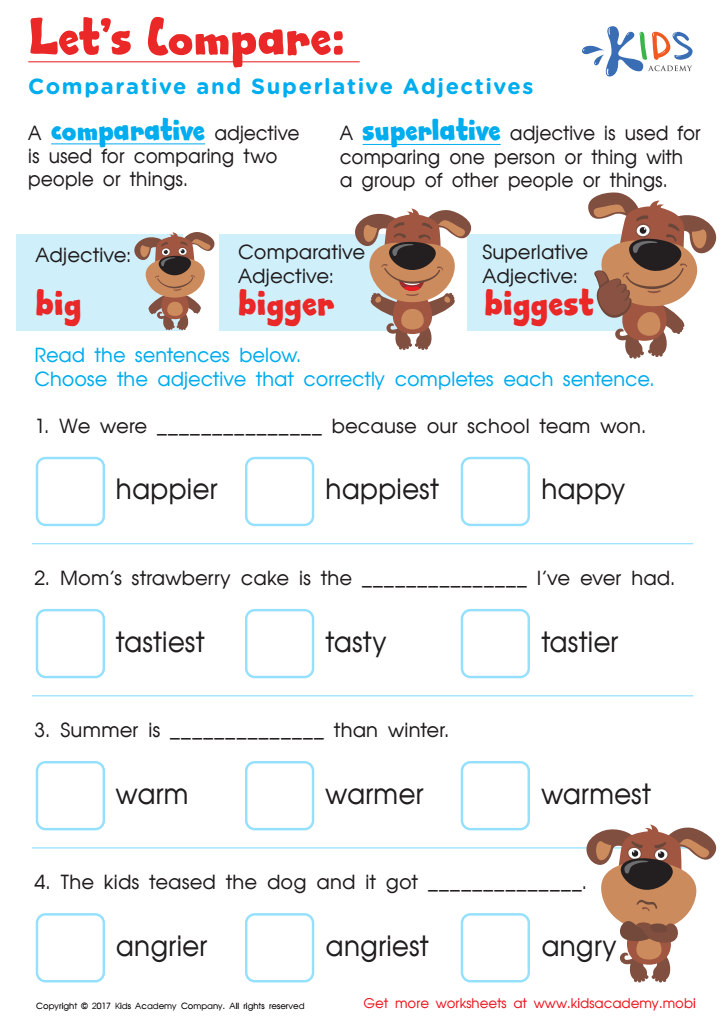
Mastering Degrees of Comparison: The Indispensable Role of Comparative and Superlative for K-12 Worksheets
In the intricate tapestry of the English language, the ability to compare and contrast is not merely a grammatical nicety; it’s a fundamental pillar of effective communication, critical thinking, and nuanced expression. From a simple observation like "This apple is bigger than that one" to a complex literary analysis stating "Shakespeare is arguably the greatest playwright of all time," comparatives and superlatives empower speakers and writers to convey relative qualities, quantities, and intensities. For students navigating the linguistic landscape from kindergarten through twelfth grade, a solid grasp of these degrees of comparison is crucial. This article delves into the profound importance and effective application of Comparative and Superlative for K-12 Worksheets, exploring how these targeted resources serve as a cornerstone for building linguistic proficiency across various developmental stages.
The Grammatical Foundation: Understanding Comparatives and Superlatives
Before exploring the pedagogical strategies, it’s essential to define the core concepts. Adjectives and adverbs, which describe nouns and verbs respectively, can change their form to show degrees of comparison.
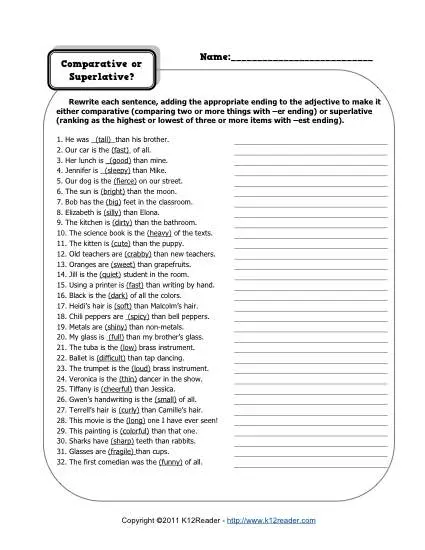
- Positive Degree: The base form of the adjective or adverb, describing a quality without comparison (e.g., tall, beautiful, quickly).
- Comparative Degree: Used to compare two things, indicating which one possesses more of a certain quality (e.g., taller, more beautiful, more quickly). It is typically followed by "than."
- Superlative Degree: Used to compare three or more things, indicating which one possesses the most of a certain quality (e.g., tallest, most beautiful, most quickly). It is typically preceded by "the."


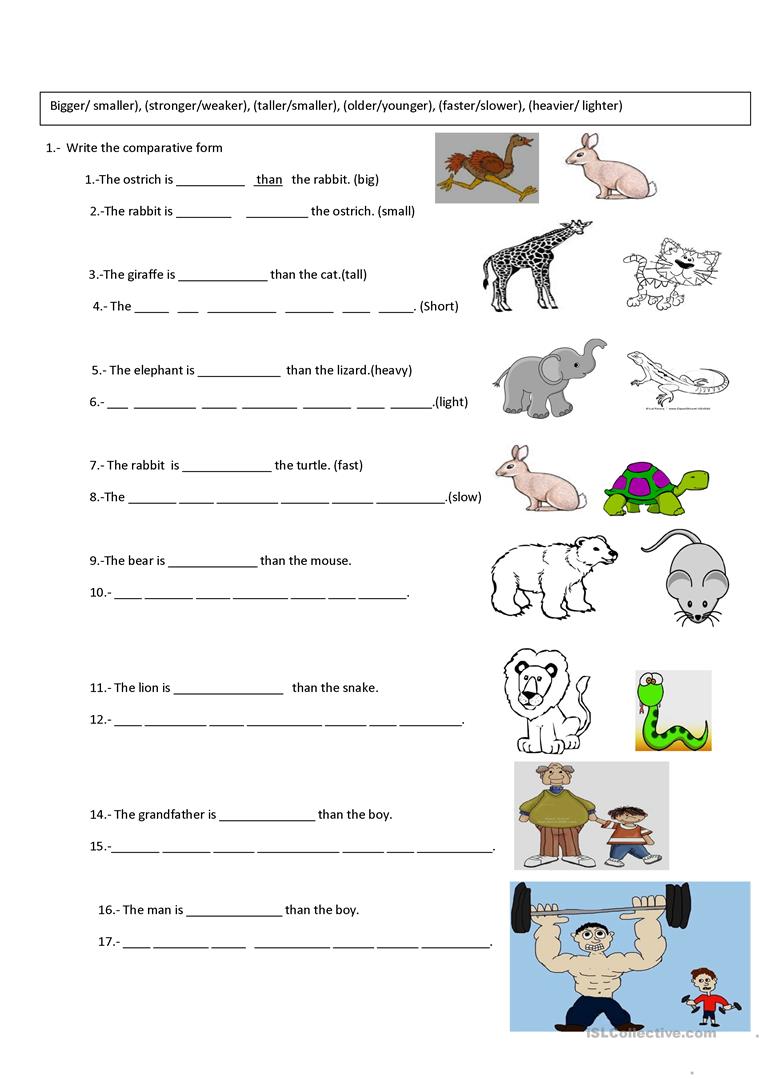

The rules for forming these degrees vary depending on the length and ending of the adjective or adverb:
- One-Syllable Words: Add "-er" for comparative and "-est" for superlative (e.g., small, smaller, smallest; fast, faster, fastest).
- Two-Syllable Words Ending in "-y": Change "y" to "i" and add "-er" or "-est" (e.g., happy, happier, happiest; easy, easier, easiest).
- Two or More Syllable Words (not ending in "-y"): Use "more" for comparative and "most" for superlative (e.g., important, more important, most important; comfortable, more comfortable, most comfortable).
- Irregular Forms: Some common adjectives and adverbs have irregular comparative and superlative forms that must be memorized (e.g., good, better, best; bad, worse, worst; far, farther/further, farthest/furthest; little, less, least).


Understanding these rules is the first step, but applying them accurately and fluently requires consistent practice, which is where Comparative and Superlative for K-12 Worksheets become invaluable.
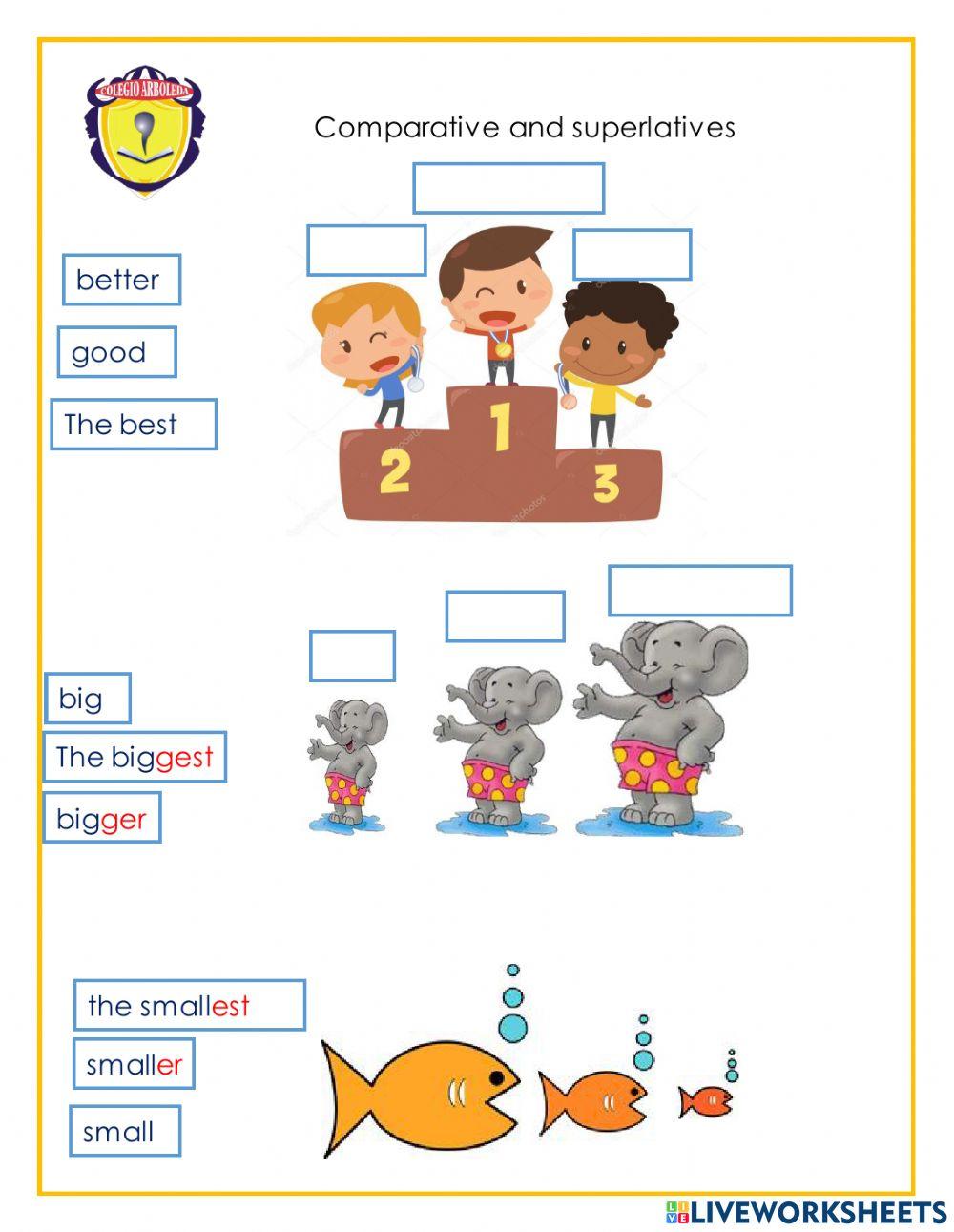
The K-12 Journey: A Graded Approach to Teaching Comparison
The beauty of the K-12 educational framework lies in its ability to introduce complex concepts in an age-appropriate, scaffolded manner. Teaching comparatives and superlatives is no exception.
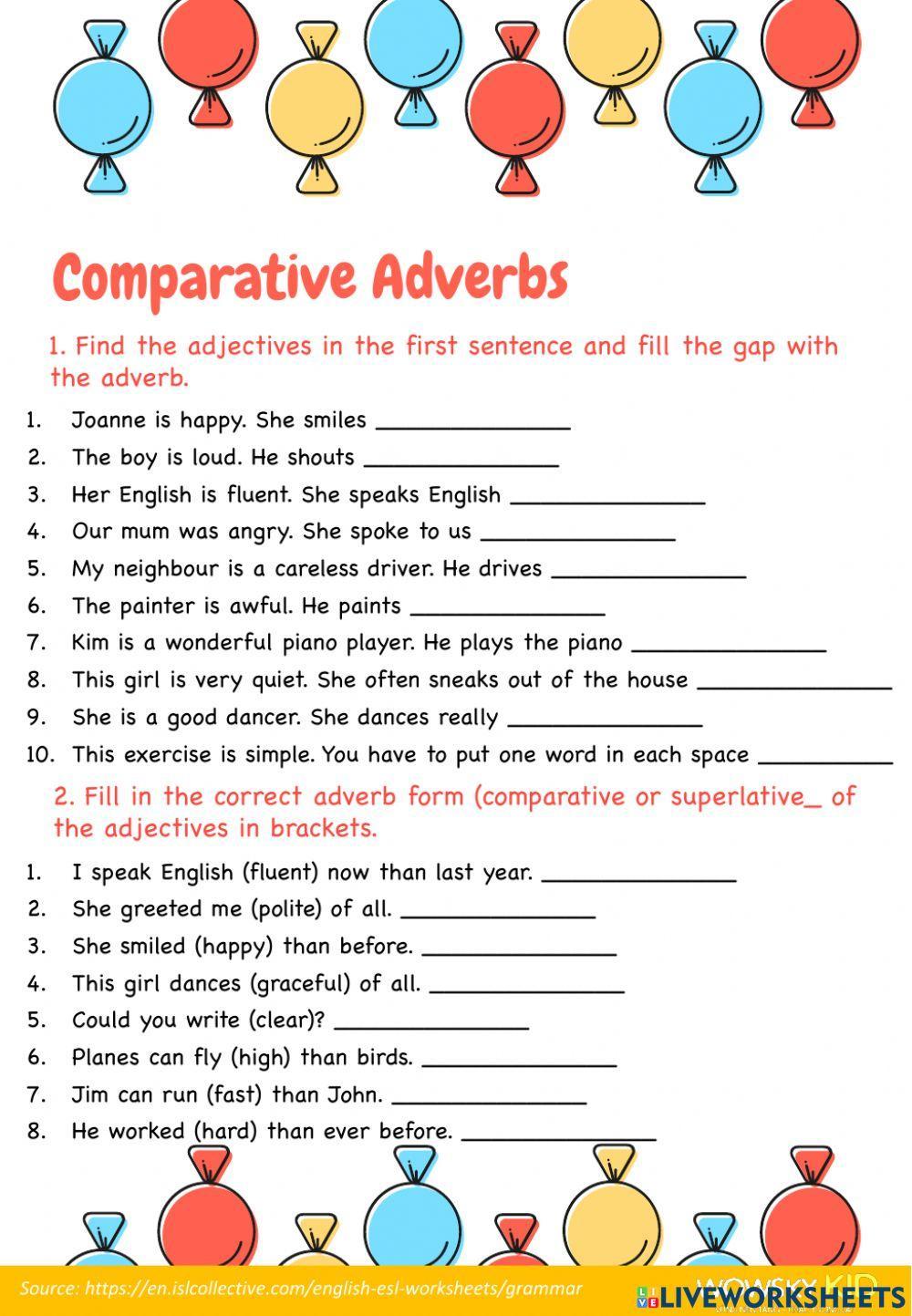
Early Elementary (Kindergarten – Grade 2): Concrete Comparisons
At this foundational stage, learning is highly visual and experiential. Worksheets should be simple, focusing on concrete objects and basic concepts.
- Focus: Introducing the idea of "more" and "most" through direct observation. Primarily focusing on one-syllable adjectives.
- Worksheet Examples:
- Picture-Based Comparisons: Students look at two pictures (e.g., a small dog and a big dog) and circle the "bigger" one. For superlatives, they might see three dogs of varying sizes and circle the "biggest."
- Fill-in-the-Blank with Word Banks: Simple sentences like "The red ball is _____ than the blue ball." (Word bank: bigger, smaller).
- Matching: Match a positive adjective (e.g., "tall") to its comparative ("taller") and superlative ("tallest") form using images.
- Pedagogical Note: Oral practice is critical here, reinforcing the worksheet activities through classroom games like "Which pencil is longer?" or "Who is the fastest runner?"
Mid-Elementary (Grades 3-5): Rule Introduction and Application
As students develop stronger reading and writing skills, the focus shifts to understanding the rules of formation and applying them to a wider range of adjectives.
- Focus: Introducing the "-er/-est" and "more/most" rules, including the "y" to "i" change. Beginning to explore irregular forms.
- Worksheet Examples:
- Transformation Tables: Students are given a positive adjective and must write its comparative and superlative forms (e.g., happy → happier → happiest).
- Sentence Completion: Providing sentences where students must choose the correct degree of comparison to complete the thought (e.g., "Mount Everest is the __ mountain in the world." (tall/taller/tallest)).
- Identifying Errors: Simple sentences with incorrect comparative/superlative usage for students to correct.
- Creative Sentence Writing: Prompts encouraging students to write their own sentences using specific comparative or superlative forms.
- Pedagogical Note: This stage is crucial for solidifying the foundational rules before more complex exceptions are introduced.
Middle School (Grades 6-8): Nuance, Adverbs, and Complex Sentences
Middle school brings an increased demand for analytical thinking and more sophisticated language use. Students begin to encounter comparatives and superlatives in more complex sentence structures and in relation to adverbs.
- Focus: Mastering irregular forms, using comparative/superlative adverbs (e.g., more quickly, most carefully), understanding exceptions and common errors (e.g., using "more" with "-er" forms).
- Worksheet Examples:
- Adverb Comparisons: Exercises specifically targeting the formation and use of comparative and superlative adverbs.
- Paragraph Correction: Students identify and correct errors in a short paragraph where degrees of comparison are misused.
- Comparative Essays/Paragraphs: Prompts requiring students to compare and contrast two subjects using a variety of comparative forms (e.g., "Compare two historical figures," "Contrast two different types of energy").
- Multiple Choice with Distractors: Questions that test subtle differences in meaning or correct usage.
- Pedagogical Note: Encouraging students to justify their choices and explain the rules behind them fosters deeper understanding.
High School (Grades 9-12): Advanced Application, Common Errors, and Literary Analysis
At the high school level, students are expected to use comparatives and superlatives with precision in academic writing, critical analysis, and persuasive arguments. The focus shifts from mere rule application to nuanced usage and identifying sophisticated errors.
- Focus: Addressing common pitfalls (e.g., double comparatives/superlatives, comparing incomparable items), understanding the impact of these forms on tone and meaning, and analyzing their use in literature.
- Worksheet Examples:
- Complex Sentence Construction: Students combine multiple ideas into a single sentence using advanced comparative or superlative structures.
- Literary Analysis: Excerpts from literature where students identify and analyze the author’s use of comparatives and superlatives to achieve specific effects (e.g., character description, mood setting, thematic emphasis).
- Error Analysis of Authentic Texts: Students analyze news articles, essays, or research papers for correct and incorrect usage, then propose revisions.
- Persuasive Writing Prompts: Require students to use compelling comparative and superlative language to support an argument (e.g., "Argue why one technological advancement is more significant than another").
- Pedagogical Note: At this level, worksheets can also serve as a diagnostic tool to identify lingering misconceptions before students tackle more extensive writing assignments.
The Power of Comparative and Superlative for K-12 Worksheets
The strategic use of Comparative and Superlative for K-12 Worksheets is paramount for several reasons:
- Targeted Practice: Worksheets allow students to focus specifically on the rules and exceptions of comparatives and superlatives without distraction, reinforcing concepts taught in class.
- Reinforcement and Repetition: Mastery in grammar often comes through consistent exposure and repetition. Worksheets provide ample opportunities for students to apply the rules multiple times, solidifying their understanding.
- Assessment and Feedback: Worksheets serve as a valuable assessment tool for teachers to gauge student comprehension and identify areas where additional instruction or practice is needed. Students also receive immediate feedback on their understanding.
- Differentiation: Well-designed worksheets can be easily differentiated to meet the needs of diverse learners. Simpler worksheets can support struggling students, while more complex ones can challenge advanced learners.
- Independent Learning: Worksheets promote independent learning, allowing students to work at their own pace and take ownership of their learning process.
- Variety of Exercises: From simple fill-in-the-blanks to complex error correction and creative writing prompts, worksheets offer a diverse range of exercises that cater to different learning styles and keep students engaged.
Designing Effective Comparative and Superlative for K-12 Worksheets
When designing Comparative and Superlative for K-12 Worksheets, several pedagogical principles should guide the process:
- Clear Instructions: Ensure instructions are concise, unambiguous, and easy for students to follow independently.
- Age-Appropriate Content: The vocabulary, sentence structure, and examples used must align with the students’ developmental stage and prior knowledge.
- Visual Appeal: Especially for younger learners, incorporate engaging graphics, illustrations, and clear layouts to make the worksheets inviting and less intimidating.
- Gradual Complexity: Start with easier exercises and gradually introduce more challenging ones within the same worksheet or across a series of worksheets.
- Variety of Exercise Types: Don’t limit worksheets to just one format. Include:
- Matching: Adjective to its comparative/superlative form.
- Multiple Choice: Choosing the correct form in a sentence.
- Fill-in-the-Blank: Supplying the correct comparative/superlative.
- Sentence Transformation: Rewriting sentences using different degrees of comparison.
- Error Identification/Correction: Finding and fixing grammatical mistakes.
- Creative Writing Prompts: Encouraging students to apply the forms in their own original sentences or paragraphs.
- Real-World Contexts: Use examples that are relevant to students’ lives and experiences to make the learning more meaningful and transferable.
- Answer Keys: Provide answer keys for self-correction or for teachers to quickly assess work. This allows students to learn from their mistakes immediately.
Beyond the Worksheet: Holistic Learning
While Comparative and Superlative for K-12 Worksheets are incredibly effective, they should be part of a broader, holistic approach to language acquisition. Complementary activities include:
- Oral Practice: Engaging in comparative discussions, debates, and games.
- Reading: Encouraging students to identify comparatives and superlatives in books, articles, and other authentic texts.
- Writing: Integrating the use of comparatives and superlatives into various writing assignments, from descriptive paragraphs to persuasive essays.
- Real-World Observation: Pointing out examples of comparative and superlative language in everyday life (e.g., advertising slogans like "the best coffee," news headlines like "the most significant discovery").
The Enduring Impact
Mastery of comparatives and superlatives is not just about grammar; it’s about empowering students to become more precise, expressive, and critical communicators. It enables them to:
- Communicate Clearly: Distinguish between qualities and quantities with accuracy.
- Enhance Writing: Add depth, detail, and descriptive power to their written work.
- Improve Reading Comprehension: Understand subtle nuances in meaning when reading complex texts.
- Develop Critical Thinking: Analyze and evaluate information by comparing and contrasting different elements.
In essence, the mastery of comparatives and superlatives, significantly supported by well-designed Comparative and Superlative for K-12 Worksheets, is not merely about grammar rules; it’s about equipping students with the linguistic tools necessary for academic success and effective communication throughout their lives. By providing structured, engaging, and progressively challenging practice, these worksheets truly make Comparative and Superlative for K-12 Worksheets an invaluable resource in every educator’s toolkit, ensuring students are well-prepared to navigate the complexities of language with confidence and clarity.
